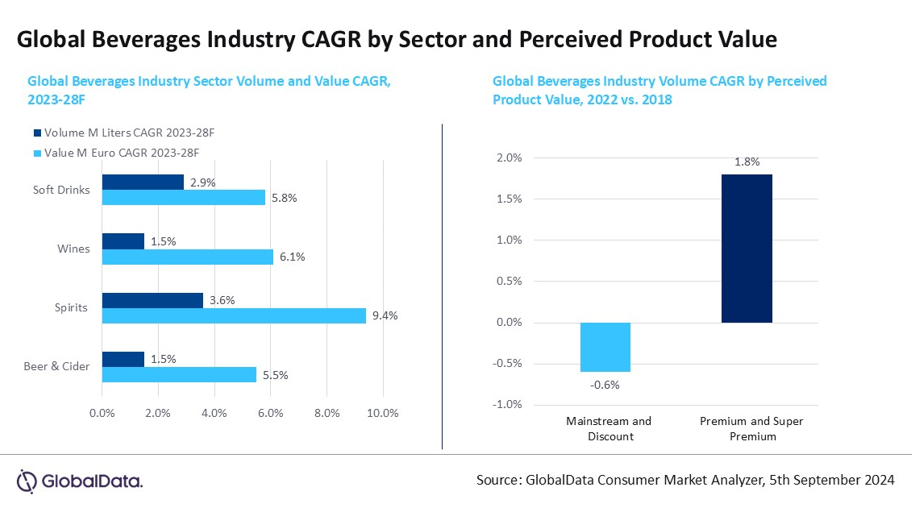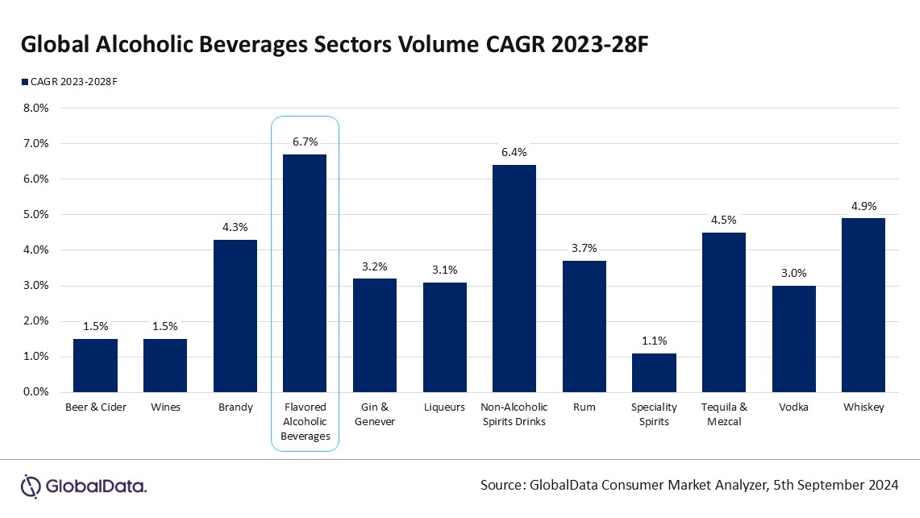
Premiumisation, convenience, a generational shift in consumer preferences and the influence of AI are shaping the direction of innovation and marketing in the spirits industry.
Those forces are fuelling the evolution of a new generation of spirits. Convenience is driving innovation across FMCG, including in spirits. Meanwhile, the growing presence of Gen Z in the workforce and rising income levels make the cohort a lucrative target for spirits brands. And investment in AI is expected to have on impact on NPD.
These are the conclusions of a new report – Next-Gen Beverages: Bridging Affordability, Sensory, and Gen Z Preferences – produced by GlobalData, Just Drinks’ parent.
Premiumisation and spirits
The spirits market is expected to achieve stronger value (9.4%) and volume (3.6%) CAGR over the next five years (2023 to 2028) than beer and cider, wines and soft drinks.

In recent years, the global beverages industry’s ‘premium’ and ‘super premium’ segments have posted strong positive volume growth globally, while the ‘mainstream’ and ‘discount’ segments have experienced declines.
Despite recent cost-of-living pressures, the trend of premiumisation is anticipated to regain its momentum and continue to drive growth, as consumers are adopt a “drink less but drink better” outlook, seeking products that offer superior craftsmanship, unique flavors, and premium ingredients.
The influence of convenience
Along with premiumisation, convenience has emerged as a central factor in the spirits sector, as modern consumers, particularly younger demographics, prioritise ease of access and on-the-go options.

This has led to the rise of flavored ready-to-drink (RTD) spirits and cocktails in portable, single-serve formats, with flavoured alcoholic beverages (FABs) projected to achieve the fastest volume CAGR (6.7%) among all alcoholic beverages sectors for the period 2023 to 2028.
These products claim to offer the same quality and complexity as traditional spirits but with added convenience, catering to busy lifestyles and the growing demand for immediate consumption. The convenience trend is further supported by advancements in packaging technology and an increased focus on affordable prices and sustainability.
Generational shifts among spirits drinkers
Coming-of-age drinkers prioritise authenticity, innovation and responsibility in their beverage choices. Unlike previous generations, they are more attuned to their preferences and priorities than to brand loyalty. These consumers are more explorative in their tastes, often seeking out new and unconventional spirits flavours, as well as exploring craft and niche brands, relying on social media and online communities to discover and share their experiences.
Gen Z’s growing presence in the workforce and rising income levels make them a lucrative target for spirits brands, and a significant challenge for alcoholic beverage marketers due to their different preferences and priorities compared to previous generations.
The influence of AI
AI-led innovations are expected to have a profound impact on the future of the spirits industry by meeting growing consumer demand for premiumisation and convenience, while also supporting the increasing drive for efficiency. AI applications in the spirits industry include product formulation, packaging design, route optimisation and customer service.
Spirits companies with a high AI capability are leaders in the sector. As consumers become more demanding, AI will play a crucial role in delivering both seamless experiences and operational excellence.



